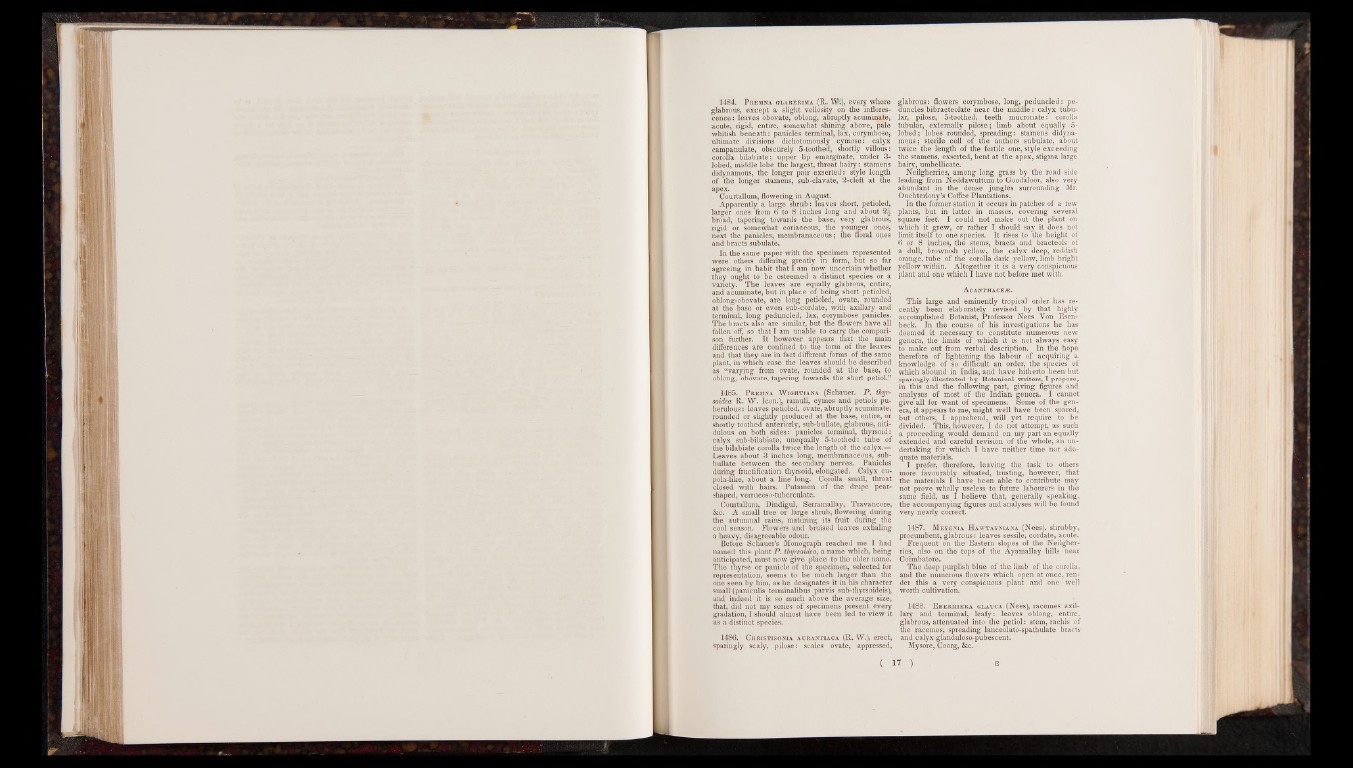
1484. Premna glaberima (R. VW), every where
glabrous, except a slight vellosity on the inflorescence:
leaves obovate, oblong, abruptly acuminate,
acute, rigid, entire, somewhat shining above, pale
whitish beneath: panicles terminal, lax, corymbose,
ultimate divisions dichotomously cymose: calyx
campanulate, obscurely 5-toothed, shortly villous:
corolla bilabiate; upper lip emarginate, under 3-
lobed, middle lobe the largest, throat hairy: stamens
didynamous, the longer pair exserted: style length
of the longer stamens, sub-clavate, 2-cleft at the
apex.
Courtallum, flowering in August.
Apparently a large shrub: leaves short, petioled,
larger ones from 6 to 8 inches long and about 2^
broad, tapering towards the base, very glabrous,
rigid or somewhat coriaceous, the younger ones,
next the panicles, membranaceous; the floral ones
and bracts subulate.
In the same paper with the specimen represented
were others differing greatly in form, but so far
agreeing in habit that I am now uncertain whether
they ought to be esteemed a distinct species or a
variety. The leaves are equally glabrous, entire,
and acuminate, but in place of being short petioled,
oblong-obovate, are long petioled, ovate, rounded
at the base or even sub-cordate, with axillary and
terminal, long peduncled, lax, corymbose panicles.
The bracts also are similar, but the flowers have all
fallen off, so that I am unable to carry the comparison
further. It however appears that the main
differences are confined to the form of the leaves
and that they are in fact different forms of the same
plant, in which case the leaves should be described
as “varying from ovate, rounded at the base, to
oblong, obovate, tapering towards the short petiol.”
1485. Premna Wightiana (Schauer. P . ihyr-
soidea R. W. Icon.), ramuli, cymes and petiols pu-
berulous: leaves petioled, ovate, abruptly acuminate,
rounded or slightly produced at the base, entire, or
shortly toothed anteriorly, sub-bullate, glabrous, niti-
dulous on both sides: panicles terminal, thyrsoid:
calyx sub-bilabiate, unequally 5-toothed: tube of
the bilabiate corolla twice the length of the calyx.—
Leaves about 3 inches long, membranaceous, sub-
bullate between the secondary nerves. Panicles
during fructification thyrsoid, elongated. Calyx cupola
like, about a line long. Corolla small, throat
closed with hairs. Putamen of the drupe pear-
shaped, verrueoso-tuberculate.
Courtallum, Dindigul, Serramallay, Travancore,
&e. A small tree or large shrub, flowering during
the autumnal rains, maturing its fruit during the
cool season. Flowers and bruised leaves exhaling
a heavy, disagreeable odour.
Before Schauer’s Monograph reached me I had
named this plant P . thyrsoidea, a name which, being
anticipated, must now give place to the older name.
The thyrse or panicle of the specimen, selected for
representation, seems to be much larger than the
one seen by him, as he designates it in his character
small (paniculis terminalibus parvis sub-thyrsoideis),
and indeed it is so much above the average size,
that, did not my series of specimens present every
gradation, I should almost have been led to view it
as a distinct species.
1486. Christisonia aurantiaca (R. W.), erect,
sparingly scaly, pilose: scales ovate, appressed,
glabrous: flowers corymbose, long, peduncled: peduncles
bibracteolate near the middle: calyx tubular,
pilose, 5-toothed, teeth mucronate: corolla
tubular, externally pilose; limb about equally 5-
lobed; lobes rounded, spreading: stamens didynamous;
sterile cell of the anthers subulate, about
twice the length of the fertile one, style exceeding
the stamens, exserted, bent at the apex, stigma large
hairy, umbellicate.
Neilgherries, among long grass by the road side
leading from Neddawuttum to Goodaloor, also very
abundant in the dense jungles surrounding Mr.
Ouchterlony’s Coffee Plantations.
In the former station it occurs in patches of a few
plants, but in latter in masses, covering several
square feet. I could not make out the plant on
which it grew, or rather I should say it does not
limit itself to one species. It rises to the height of
6 or 8 inches, the stems, bracts and bracteols of
a dull, brownish yellow, the calyx deep, reddish
orange, tube of the corolla dark yellow, limb bright
yellow within. Altogether it is a very conspicuous
plant and one which I have not before met with.
Acanthace£ .
This large and eminently tropical order has recently
been elaborately revised by that highly
accomplished Botanist, Professor Nees Von Esen-
beck. In the course of his investigations he has
deemed it necessary to constitute numerous new
genera, the limits of which it is not always easy
to make out from verbal description. In the hope
therefore of lightening the labour of acquiring a
knowledge of so difficult an order, the species of
which abound in India, and have hitherto been but
sparingly illustrated by Botanical writers, I propose,
in this and the following part, giving figures and
analyses of most of the Indian genera. I cannot
give all for want of specimens. Some of the genera,
it appears to me, might well have been spared,
but others, I apprehend, will yet require to be
divided. This, however, I do not attempt, as such
a proceeding would demand on my part an equally
extended and careful revision of the whole, an undertaking
for which I have neither time nor adequate
materials.
I prefer, therefore, leaving the task to others
more favourably situated, trusting, however, that
the materials I have been able to contribute may
not prove wholly useless to future labourers in the
same field, as I believe that, generally speaking,
the accompanying figures and analyses will be found
very nearly correct.
1487. Metenia Hawtayniana (Nees), shrubby,
procumbent, glabrous: leaves sessile, cordate, acute.
Frequent on the Eastern slopes of the Neilgherries,
also on the tops of the Ayamallay hills near
Coimbatore.
The deep purplish blue of the limb of the corolla,
and the numerous flowers which open at once, render
this a very conspicuous plant and one well
worth cultivation.
1488. Ebermiera glatjca (Nees), racemes axillary
and terminal, lea fy : leaves oblong, entire,
glabrous, attenuated into the petiol: stem, rachis of
the racemes, spreading lanceolato-spathulate bracts
and calyx glanduloso-pubescent.
Mysore, Coorg, &c.
( w )